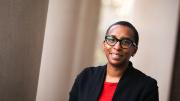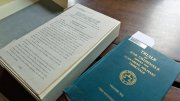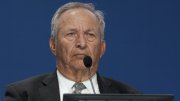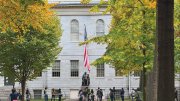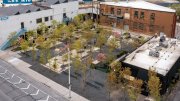At the Faculty of Arts and Sciences (FAS) meeting on November 1, Dean Claudine Gay presented a new look on the 2021-2022 academic and financial year: an annual report in which she has seemingly edited her own presence to an absolute minimum. In place of the traditional published letter from the dean, followed by academic or other highlights, she chose to address colleagues briefly during the meeting, and then turned the Zoom screen over to Nina Zipser, dean for faculty affairs and planning (whose report on faculty trends is covered separately here), and Scott Jordan, dean of administration and finance. His report on matters fiscal (reported below), was full of good cheer: a substantial surplus, a record level of unrestricted cash reserves, and remarkable control of expenses.
That may set the stage for FAS establishing new priorities—operational, organizational, and perhaps intellectual—as faculty members continue the strategic planning process Gay set in motion during the pandemic. At the October 11 faculty meeting, she asked colleagues to save two dates: next January 20, for a planning status report; and August 30, for a full faculty retreat on the results of the planning, and, presumably, steps toward implementation.
Assisting the Faculty
At yesterday’s gathering, Gay responded to a question posed during the prior meeting by James Engell, Gurney professor of English literature and professor of comparative literature—one that touched on some of the matters pertaining to strategic planning, and to the resource issues that Jordan manages. Referring to the recently completed report of the Faculty Workload Committee, he had inquired about the number of faculty assistants and other support personnel distributed across FAS who attend to booking travel, filing expense reports, providing course support, coordinating requests for recommendations, and otherwise enabling professors to focus their talents and energies on research and teaching. Within the arts and humanities division, he said then, it was his impression that faculty members had essentially no such support.
Thus prompted, Gay reported back with stunning findings. She had expected to learn that across the faculty’s diverse disciplines, ranging from large research laboratory operations to smaller-scale scholarship, faculty assistant resources would be distributed unevenly. In fact, she said, arts and humanities faculty members were woefully understaffed, absolutely and relative to other divisions. The data compiled so far show 83 faculty assistants or similar positions within the science division; 27 in social science (plus six more in a divisional services group); and within arts and humanities (which has 195 ladder faculty members) a total assistant cohort of three—which she deemed “no support, practically speaking.” Recognizing that “all faculty should be able to rely on a baseline level of support,” she continued, she asked Dean Jordan and division leaders to develop appropriate, reliable, and professional staff commensurate with the need, “as an urgent priority.”
It is that sort of finding, FAS-wide, that some of the early strategic planning studies (from which the workload committee emerged) have surfaced. Beyond basic matters of efficient, productive use of faculty members’ time and expertise, there are clearly opportunities to make FAS a better place to work, with implications for recruiting and retention of professors: the fundamental concerns Zipser’s office addresses daily.
Dean Gay’s Report
The dean’s report was a brief overview of FAS’s current condition and aspirations, sketched in the broadest terms. She began by noting that FAS proved to be “an institution that has been resilient” through the pandemic, reflecting both hard work by departments, divisions, and the FAS as a whole and a willingness to set priorities that “really met the urgency of the moment.” Part of doing so, she acknowledged, meant making sacrifices and not pursuing attractive opportunities in light of pandemic exigencies and perceived resource constraints—steps for which she was “profoundly grateful.”
Gay reminded the faculty that it did not sacrifice “our academic excellence,” instead maintaining recruiting and faculty renewal during 2021-2022. (For details, see Zipser’s report, which details somewhat more growth in the faculty ranks than expected.) In addition, FAS sustained its priority on “access,” including such steps as the recent increase in the family-income threshold, from $65,000 to $75,000, beneath which College students attend free of tuition and fees—effective with the new class of 2026. She also detailed increases in certain graduate student stipends and insurance benefits.
FAS, she said, is in “an enviable position today,” emerging with financial strengths that could not have been predicted when the pandemic began. That made her optimistic about the future, Gay continued, and the faculty’s strategic planning would “join that optimism with intentionality,” in a faculty-led effort to set FAS’s course. Given changes in disciplines, institutions, society, and what students want, she said, FAS was “leaning into the moment” through self-study and planning. Although the faculty members had to invest their time to do this work, she noted, it was yielding results—for example, the actions to remedy inequities in the nonacademic workload.
The outcome, she said, would be “a Harvard that works better for our faculty and our students.” By rejecting the passive accretion of past practices, she said, FAS could become “better and smarter”. She saw “the light at the end of the tunnel,” as the faculty realized the benefits that members’ efforts are shaping.
For details on the faculty itself, she then introduced Dean Zipser for the faculty trends report.
A Fiscally Fit FAS
At moments of real or perceived financial stress within the University, attention naturally turns to FAS, with its 11,000 students, 10 million square feet of facilities, and dozens of diverse, heterogeneous disciplines, whose work requires libraries, museums, laboratories, classrooms, and more—all of which depend on strong, consistent endowment returns and a healthy slug of tuition and sponsored research support. The financial crisis and Great Recession beginning in 2008 badly damaged the endowment, impairing FAS operations across the board. At the outset of the pandemic, the faculty, again operating without substantial unrestricted reserves and carrying substantial debt from House Renewal and other capital spending, once more seemed at risk.
But as the fiscal year 2021 report revealed, reduced campus operating expenses, successful online instruction for a significant share of the student body, and resumed research operations yielded an unexpectedly good result: a $51.3 million operating surplus (consolidating the results of FAS, other operations, and the School of Engineering and Applied Sciences—SEAS).
In reviewing fiscal 2022 yesterday, Jordan had plenty more good news. FAS’s financial statements show a consolidated surplus this year of $84.9 million. (Speaking to the faculty, he used data for FAS alone, excluding SEAS. On that basis, the cash surplus was $99 million.)
•The year in review. Again reporting for FAS as a standalone entity, Jordan noted that revenues reached $1.519 billion, up from $1.406 billion in fiscal 2021, and exceeding the pre-pandemic, fiscal 2019 total for the first time. Students returning to campus drove that growth: with enrollment up 1,716 from the severely depressed level of the prior year, tuition, room, board, and fees increased $114 million. Current-use giving declined $8 million (to $115 million), but the endowment distribution rose from $764 million to $791 million. With in-person instruction resumed, continuing education revenue slipped, but sponsored support for research held steady, at $191 million.
Expenses remained reasonably controlled, increasing from $1.356 billion to $1.450 billion. With campus operations resuming, the associated non-compensation costs (space and occupancy, services purchased, and so on) rose $105 million from fiscal 2021, including some $16 million in COVID-related expenses for testing and isolation housing. But employee compensation costs—salaries, wages, and benefits—actually declined $11 million (to $651 million), with both the salaries and wages and the benefits lines decreasing. The former reflects a workforce that remains smaller than in fiscal 2019, the joint result of a voluntary retirement program early in the pandemic and persistent difficulty in hiring in the current market. The latter reflects decreased utilization of employee benefits.
Reserves. Of the cash surplus, Jordan’s report revealed, nearly $72 million was added to the dean’s unrestricted reserves—bringing that cushion, and an invaluable source of funds to invest in academic initiatives, to $159 million, or roughly 10 percent of FAS’s operating expenses, in line with the Corporation’s guidance for such reserves. This is the first time FAS has achieved that target.
The shortage of unrestricted cash available to the dean constrained academic investments and faculty growth (see the data in Zipser’s report) beginning late in the first decade of this millennium, and those foundational intellectual investments have continued to be constrained despite the fruitful Harvard Campaign conducted under President Drew Faust. Accumulating those hard-won reserves now (in part through a debt restructuring FAS effected with the central administration in fiscal 2017, which increases cash reserves in the early years, but, reciprocally, increases debt repayments in later years) gives Gay and the FAS financial options it has not had in more than a decade. Hence the timing and importance of the strategic planning, which presumably aims to make the best possible use of that unusual opportunity.
Long-term prospects. Jordan also reviewed FAS’s new long-term financial model, which initially showed a structural deficit of $1.8 billion—translating into an annual operating deficit of an unsustainable $90 million of red ink in perpetuity. In a striking exhibit of FAS’s endowment dependence, he noted, the 33.6 percent return on investments in fiscal 2021 had the effect of reducing that structural deficit to some $600 million—and shrinking the operating gap accordingly, to a more manageable $30 million. But, he continued, the more recent endowment results (a negative 1.8 percent return in fiscal 2022) and the sharp increase in the rate of inflation will result “in a larger structural deficit estimate,” and annualized budget gap, when the model is rerun later this year.
In all, he told the faculty members, FAS is “in relatively good fiscal health.” It remains vulnerable to important factors outside its control—especially endowment returns and the rate of inflation. But it has within its control the success of its fundraising, which has been robust throughout the pandemic; compensation (which will increase somewhat with inflation) and hiring (which is planned to increase); space use (changing after the pandemic); enrollment in the Extension School; and effective management of reserves and restricted funds within departments and programs. In the face of a volatile economic climate, he concluded, FAS is “in a good place”—an outcome beyond the faculty’s wildest dreams in the spring of 2020.
The annual financial report, available here, includes much of Jordan’s narrative and FAS’s unaudited financial statements (with details on financial aid, capital spending, the endowment distribution and assessments, FAS’s long-term debt, and more).
